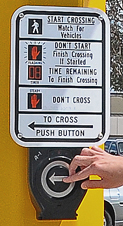Americans with Disabilities Act

All MnDOT projects - both new construction and rehabilitation projects - must include evaluation to ensure compliance with the Americans with Disabilities Act. Components can include, but are not limited to adding curb cuts, truncated domes and accessible pedestrian signals. Read about MnDOT's transition plan to comply with the ADA.
Specifics for this study
This study provided recommendations on accessibility needs for pedestrians and bicyclists. Read the study findings or the Safety Concept Recommendations report (PDF) for more details.
- Switching to protected left turns will reduce conflicts between cyclists and pedestrians.
- Leading pedestrian intervals enhance pedestrian safety at intersections by showing the walk signal 3-7 seconds before vehicles receive green light, increasing pedestrians' visibility to drivers.
- Limiting right turns on red will reduce conflicts between people walking and driving.
- Implementing pedestrian recall so that the signals activate every signal cycle without being pushed.
- Implementing high-visibility enhancements to pedestrian crossings.
- Tightening curb radii with pavement markings and bollards improves pedestrian visibility, shortens pedestrian crossing distances and creates better aligned curb ramps.
